Leucospermum heterophyllum
Leucospermum heterophyllum (Thunb.) Rourke
Family: Proteaceae
Common names: trident pincushion, snakebush (Eng.); rankluisie, slangbossie (Afr.)
Introduction
This is a wonderful cascading fynbos shrub that spreads widely and produces numerous flowerheads, displaying shades of yellow, green and red that gradually fades to carmine, from spring to midsummer.
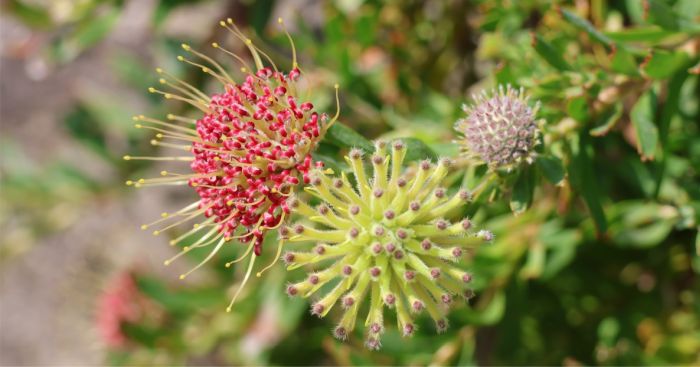
Description
Description
Leucospermum heterophyllum is an evergreen shrub that forms dense mats, spreading 1-6 m in diameter and reaching 0.1-0.15 m in height. The plant develops a woody rootstock, with flexible branches that spread horizontally across the ground. This species produces a variety of leaf shapes, ranging from oblanceolate to linear-spatulate, with a tip that bears one or three glandular teeth. The leaves are stalkless, twisted so that they are pointing vertically to the horizontal stem, hairy when young and hairless or smooth when they mature.
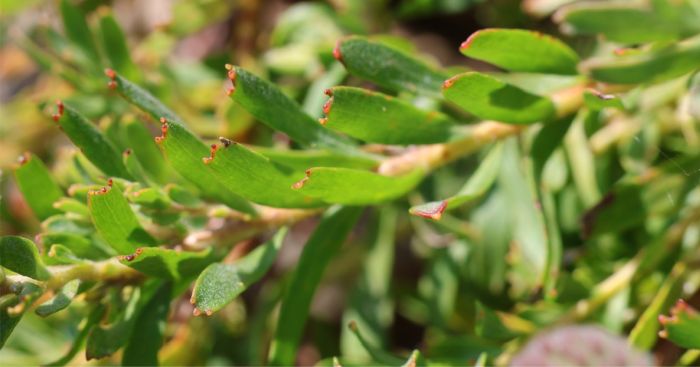
The globose flowerheads are 20-30 mm in diameter, borne on short stalks of 10-20 mm and usually arising on short lateral flowering branchlets. The involucral bracts are yellow-green, enclosing the straight, pale yellow style, that measures 18-21 mm long. As the flower matures, the style becomes dull carmine, with a yellow pollen presenter at the tip. The flowering season takes place during spring and early summer (August to January) and releases the seeds one to two months after flowering.
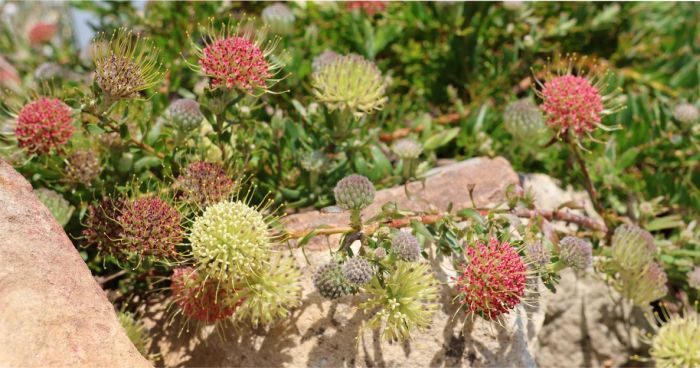
Conservation Status
Status
For the past 100 years, the habitat of Leucospermum heterophyllum has declined significantly due to several threats. The species grows on fertile ferricrete (iron-rich) soils, which are quite different from the nutrient-poor soils of fynbos. Approximately 30% of its population has been lost over the past three generations as a result of agriculture, urban expansion, gravel mining, overgrazing and alien invasive plants. Alien species such as Australian acacias and hackeas severely impact the species’ habitat by outcompeting the indigenous species. Too frequent fires also negatively affect the habitat. As a result, the wild population continues to decline and Leucospermum heterophyllum is listed as Vulnerable (VU) on the Red List of South African Plants. Most subpopulations consist of fewer than 250 individual plants that are found growing along the road verges and fragments patches near crop fields. A small portion of its habitat is protected in the Agulhas National Park and Heuningberg Nature Reserve.
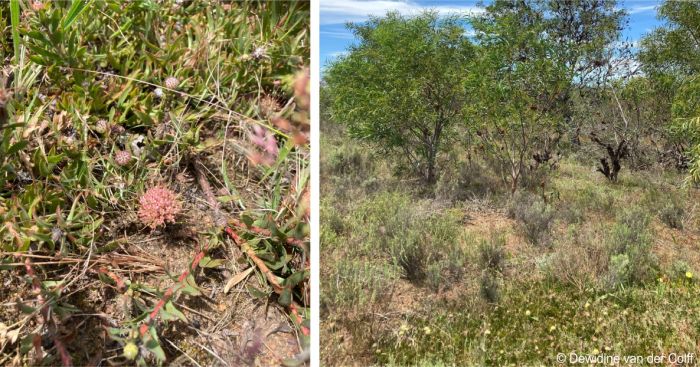
Distribution and habitat
Distribution description
Leucospermum heterophyllum is naturally found in the Western Cape, ranging from Elim at Wolvengat to De Hoop. The species typically grows in patches on sandstone or shale conglomerates, mainly at altitudes of 150–200 m. In some areas, it also occurs on soils derived from fine-grained greywacke, a type of conglomerate belonging to the Malmesbury Series. Interestingly, a few plants have also been recorded in sandy soils of the Tertiary deposits, which is unusual for the species.
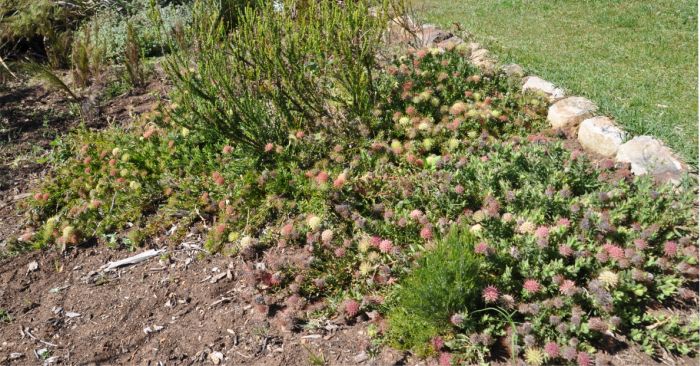
Derivation of name and historical aspects
History
Leucospermum heterophyllum belongs to the protea family (Proteaceae) and is indigenous to South Africa. The generic name Leucospermum means ‘white seed’ and is derived from the Greek words leukos (white) and sperma (seed). The genus name was given by Robert Brown in 1810. The white seed refers to the pale, fleshy layer that covers the seed, known as an elaiosome or ant-fruit, which was only formally described in 1984. The species name heterophyllum is derived from Greek words, meaning ‘unequal’ or ‘different’ and ‘leaves’ likely referring to the species distinctive trident-tipped leaves. Because of these distinctive three-toothed leaves, the plant is commonly known as the trident pincushion.
Leucospermum heterophyllum was first collected in the early 18th century, either by Oldenland or Auge, with the specimen preserved in N.L. Burman’s herbarium in Geneva. Though specimens were also collected by Thunberg and Masson, that are housed in the Uppsala Herbarium and the British Museum. However, the exact dates of these collections remain unknown. There is also no published record confirming whether, during their travels between 1773 and 1774, Thunberg and Masson passed through Elim to Bredasdorp, a distance of about 32 km. Three sheets were later found in Thunberg’s herbarium under the name Protea heterophylla. Two of these sheets bear specimens with entire leaves, while another sheet (mounted 2921) provides a more accurate description of the glabrous, tridentate leaves typical of Leucospermum heterophyllum, compared with those labeled Protea heterophylla B (mounted 2922, 2923).
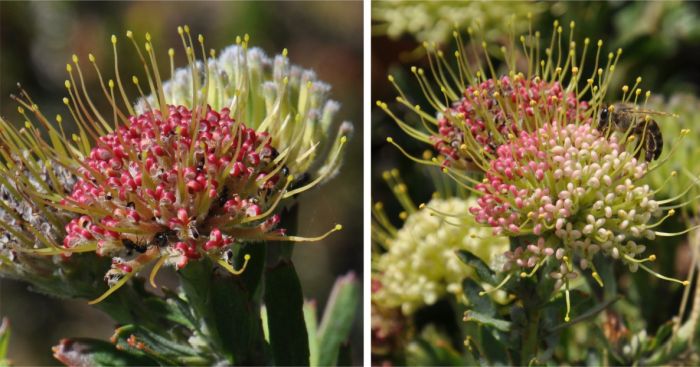
Ecology
Ecology
Leucospermum heterophyllum is primarily pollinated by insects. At Kirstenbosch NBG bees, ants and beetles have been observed visiting the flowers.
Its seeds are dispersed by ants, which carry them to their underground nests. The ants feed on the fleshy elaiosome attached to the seed, but not on the seed itself. Once discarded, the seeds remain buried in the nest, protected from fire and seed predators which contributes to their conservation.
The seeds are also consumed by rodents, korhaans, pigs, and squirrels. Rodents, in particular, feed on both the seeds and the nectar that accumulates in the perianth tube, and may act as occasional pollinators in the process. They may also feed on seedlings that emerge in post-fire environments. During nectar feeding, rodents can cause damage by chewing the style and perianth.
Invasive Argentine ants pose another serious threat as they feed on the elaiosome but do not bury the seed. As a result, exposed seeds are left vulnerable to fire or predation by animals. Seed germination is delayed by the hard seed coat, which restricts oxygen from reaching the embryo. Buried seeds usually germinate when cool nighttime soil temperatures coincide with the removal of senescent plants by fire.
Leucospermum heterophyllum has evolved a strong resilience to fire. While branches are destroyed, the plant survives through its thick bark and woody rootstock, producing new shoots from the basal branches. This fire-adapted strategy contributes to its long generation length, estimated at 50–100 years.
Uses
Use
Leucospermum heterophyllum is an ideal plant for cascading and can be used on medium sized rock retaining walls, rockeries or sloping areas where it can be clearly visible and covers the area. It is also an excellent groundcover. Best suited to fynbos, or winter-rainfall gardens, with well-drained soils.
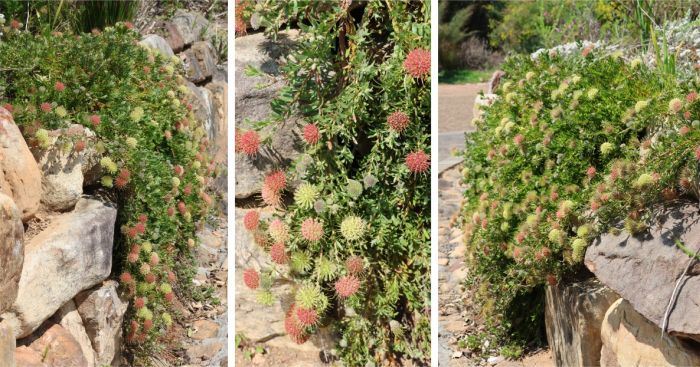
Growing Leucospermum heterophyllum
Grow
Leucospermum heterophyllum can be propagated from semi-hardwood cuttings taken in autumn or spring. Collect cuttings early in the morning to reduce moisture loss and mist them lightly with water when collecting. Cuttings are treated with a rooting hormone for about 5 seconds to stimulate root formation. Insert the cuttings in a well-drained, aerated medium consisting of either 70% perlite and 30% fine bark, or a mixture of coarse sand and finely milled pine bark. The cuttings should be placed on tray with sufficient space to allow for air circulation. Place trays on heated benches at ±25 °C under intermittent misting.
Cuttings should be treated regularly with fungicide to prevent fungal infections. Remove any dead leaves or wilting cuttings during the rooting process. Once rooted, move the cuttings to a hardening-off house for about two weeks, then pot them into small nursery bags filled with a well-drained, acidic growing medium.
Seeds can be collected one to two months after flowering, when florets begin turning brown. Harvest seed heads, dry them, and clean to extract the seeds. Since the seeds are hard and covered by an elaiosome, soak them in a 1% hydrogen peroxide solution for 24 hours to soften the seed coat. Rub the seeds gently in a bag or by hand to remove the elaiosome. Discard any soft or squashed seeds, as these are immature.
Treat seeds with fungicide before sowing, and continue weekly applications to prevent fungal infections, as seedlings are highly susceptible. Sow seeds in autumn, between March and May, in a well-aerated medium, applying smoke treatment with dry and green fynbos material to stimulate germination. Seedlings are ready for potting-up once they have produced their first true leaves, which helps reduce wilting and improves survival rates. Both seedlings and rooted cuttings should be kept under a shade net that reduces direct sunlight, prevents scorching, and helps retain soil moisture in nursery bags. Once the plants have developed strong roots, they may gradually be moved into full sun and planted out after two to three years.
When planting in the garden, keep the soil moist by applying a 5 mm layer of mulch. This helps cool the roots, conserve soil moisture, and suppress weed growth.
References
- Duncan, G., Brown, N. & Nurrish, L. 2013. Grow proteas. Kirstenbosch Gardening Series. South African National Biodiversity Institute, Cape Town.
- Nndanduleni, M. 2020. Leucospermum harpagonatum Rourke. (Proteaceae). PlantZAfrica. Online. https://pza.sanbi.org/leucospermum-harpagonatum.
- Protea Atlas Project. Leucospermum R.Br. 1810. https://www.proteaatlas.org.za/PROTEA_ATLAS_main_part6.pdf.
- Rebelo, A.G. 2001. Proteas. A field guide to the proteas of southern Africa. Fernwood Press, Vlaeberg, Cape Town.
- Rebelo, A.G., Mtshali, H. & Von Staden, L. 2020. Leucospermum heterophyllum (Thunb.) Rourke. National Assessment: Red List of South African Plants. https://redlist.sanbi.org/species.php?species=795-35.
- Rourke, J.P. 1972. Taxonomic studies on Leucospermum R.Br. Journal of South African Botany, Supplementary Volume 8
- Van Der Colff, D. 2021-Oct. Observation of Leucospermum heterophyllum, Zandvlakte, Agulhas Plain. iNaturalist. Online. https://www.inaturalist.org/observations/141358636.
- Wikipedia, The Free Encyclopedia. Leucospermum heterophyllum. https://en.wikipedia.org/wiki/Leucospermum_heterophyllum. Accessed on 2025/09/08.
Credits
Mashudu Nndanduleni
Thohoyandou National Botanical Garden
September 2025
Acknowledgements: Images of Leucospermum heterophyllum in habitat by Dewidine van der Colff.
Plant Attributes:
Plant Type: Shrub
SA Distribution: Western Cape
Soil type: Sandy, Loam
Flowering season: Spring, Early Summer
PH: Acid, Neutral
Flower colour: Green, Red, Cream, Yellow
Aspect: Full Sun
Gardening skill: Average
Special Features:
Horticultural zones
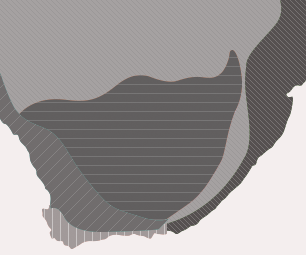






Rate this article
Article well written and informative
Rate this plant
Is this an interesting plant?
Login to add your Comment
Back to topNot registered yet? Click here to register.